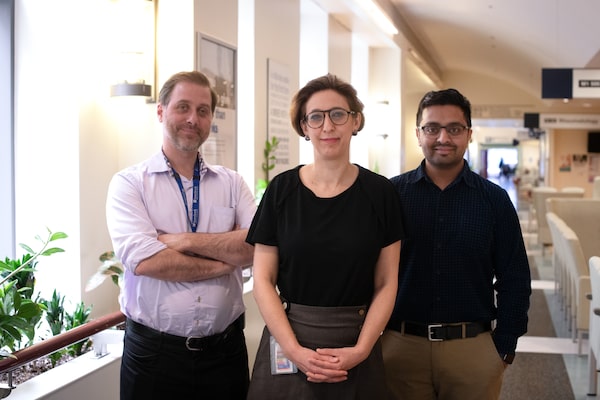
The researchers involved in isolating the virus: Dr. Rob Kozak and Dr. Samira Mubareka of the University of Toronto, and Dr. Arinjay Banerjee of McMaster University.Supplied/Sunnybrook Hospital
Two teams of Canadian scientists have isolated the coronavirus that causes COVID-19 and successfully reproduced it in the laboratory.
The accomplishment means that researchers who are looking to test screening methods, therapies and vaccines now have Canadian sources that can provide access to the global pathogen without them having to undertake the complicating step of shipping live virus across international borders.
Coronavirus guide: The latest news on COVID-19 and the toll it’s taking around the world
Should I cancel my plans? How to get social distancing right in the coronavirus outbreak
“The significance for us is that it serves as a tool," said Samira Mubareka, a microbiologist at Sunnybrook Health Sciences Centre in Toronto and member of one of the teams. “Now that we have this virus in hand it means that we have material for a number of things."
Dr. Mubareka and her colleagues at McMaster University in Hamilton and the University of Toronto worked in a facility in the Toronto area with the appropriate containment level to handle the new coronavirus safely. They announced their feat on Thursday.
On Friday, Paul Hodgson, associate director of business development at the Vaccine and Infectious Disease Organization-International Vaccine Centre in Saskatoon, confirmed to The Globe and Mail that the joint federal-provincial facility had quietly reached the same milestone a few weeks earlier and is now using its version of the virus for a vaccine development effort.
Samples of the Saskatoon-derived version of the coronavirus are now available for approved research groups through the National Microbiological Laboratory in Winnipeg. The Ontario group also plans to generate its version for distribution.
The spread of the novel coronavirus that causes COVID-19 continues, with more cases diagnosed in Canada. The Globe offers the dos and don'ts to help slow or stop the spread of the virus in your community.
The Globe and Mail
In both cases, the virus was isolated from clinical samples obtained from patients at Sunnybrook, the first hospital in Canada to treat someone with COVID-19. However, the Toronto and Saskatoon isolates are from different patients and so may vary in ways that will be important for scientists looking to detect or target the virus.
They are also different from a version of the virus isolated by the U.S. Centers for Disease Control and Prevention and documented in a paper posted online last week. That version is intended to be the reference strain for scientists working in the United States.
“I think having multiple virus isolates is incredibly valuable,” Dr. Hodgson said. “We can see whether one vaccine or therapy works across all the virus strains ... if there are known [genetic] variations.”
Dr. Mubareka said that for the Ontario-based team, the process of isolating the virus began with a relatively standard procedure that did not work the first time. Hurdles along the way had to be surmounted with some additional scientific tricks. The group ultimately succeeded in getting the virus to reproduce in animal cells that were engineered to have no immune response and specially treated to enhance the likelihood of infection.
The first sign that the method was working surfaced when the group spotted “plaques” in their cell cultures –patches of dead cells that were destroyed by the virus.
“We did the infection from clinical specimens on a Friday,” said Arinjay Banerjee, a postdoctoral researcher at McMaster University’s Institute for Infection Disease Research. “Then to go back on Monday and see all [the] cells dead – that was pretty exciting. That was step one.”
Dr. Mubareka said that one of the first uses for the isolate would be to act as a control to make sure that tests used by health-care workers to identify the virus are performing as expected. It could also serve as a “challenge” strain for antiviral drugs and vaccines currently in development.
Karen Mossman, a professor of pathology and molecular medicine at McMaster, said that researchers there would be working with the isolates to better understand details about the biology of COVID-19, including how the virus works to counteract the human immune response.
She added that there was a certain irony in trying so hard to create a virus that “everyone else is trying to get rid of.”
Dr. Hodgson said the virus isolated in Saskatoon has now been used to establish the virus in ferrets that can be used to test the efficacy of vaccines in living organisms before human clinical trials commence.
Last week, the western facility received a $1-million grant to advance its work as part of a funding competition organized by the Canadian Institutes for Health Research, which selected 47 teams working on various aspects of the COVID-19 outbreak.
The Ontario collaboration was not among the winners and, until now, a lack of funding has been the team’s biggest challenge, Dr. Mubareka said.
On Friday, the federal agency said it would be able to support 49 additional projects with a portion of the $1.1-billion COVID-19 response package announced earlier in the week by Prime Minister Justin Trudeau. Among them is a proposal by Dr. Mossman’s group at McMaster to study the biology of how the virus interacts with its hosts and to model this interaction in laboratory experiments
Our Morning Update and Evening Update newsletters are written by Globe editors, giving you a concise summary of the day’s most important headlines. Sign up today.